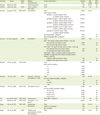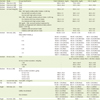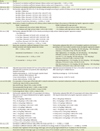1. Clément K, Ferré P. Genetics and the pathophysiology of obesity. Pediatr Res. 2003; 53:721–725.

2. Flegal KM, Kruszon-Moran D, Carroll MD, Fryar CD, Ogden CL. Trends in obesity among adults in the United States, 2005 to 2014. JAMA. 2016; 315:2284–2291.

4. Daniels SR, Arnett DK, Eckel RH, Gidding SS, Hayman LL, Kumanyika S, Robinson TN, Scott BJ, St Jeor S, Williams CL. Overweight in children and adolescents: pathophysiology, consequences, prevention, and treatment. Circulation. 2005; 111:1999–2012.
5. Flodmark CE, Lissau I, Moreno LA, Pietrobelli A, Widhalm K. New insights into the field of children and adolescents’ obesity: the European perspective. Int J Obes Relat Metab Disord. 2004; 28:1189–1196.

6. Dietz WH. Childhood weight affects adult morbidity and mortality. J Nutr. 1998; 128:Suppl. 411S–4S.

7. Oh SW. Obesity and metabolic syndrome in Korea. Diabetes Metab J. 2011; 35:561–566.

8. Ministry of Health and Welfare, Korea Centers for Disease Control and Prevention. Korea Health Statistics 2007??009: Korea National Health and Nutrition Examination Survey (KNHANES IV). Cheongwon: Korea Centers for Disease Control and Prevention;2008??010.
9. Ministry of Health and Welfare, Korea Centers for Disease Control and Prevention. Korea Health Statistics 2010??012: Korea National Health and Nutrition Examination Survey (KNHANES V). Cheongwon: Korea Centers for Disease Control and Prevention;2011??013.
10. Ministry of Health and Welfare, Korea Centers for Disease Control and Prevention. Korea Health Statistics 2013: Korea National Health and Nutrition Examination Survey (KNHANES VI-1). Cheongju: Korea Centers for Disease Control and Prevention;2014.
11. Slochower J, Kaplan SP, Mann L. The effects of life stress and weight on mood and eating. Appetite. 1981; 2:115–125.

12. Garenc C, Vohl MC, Bouchard C, Pérusse L. LIPE C-60G influences the effects of physical activity on body fat and plasma lipid concentrations: the Quebec Family Study. Hum Genomics. 2009; 3:157–168.

13. Hubert HB, Feinleib M, McNamara PM, Castelli WP. Obesity as an independent risk factor for cardiovascular disease: a 26-year follow-up of participants in the Framingham Heart Study. Circulation. 1983; 67:968–977.

14. Alberti KG, Zimmet P, Shaw J. Metabolic syndrome--a new world-wide definition. A Consensus Statement from the International Diabetes Federation. Diabet Med. 2006; 23:469–480.

15. Friedewald WT, Levy RI, Fredrickson DS. Estimation of the concentration of low-density lipoprotein cholesterol in plasma, without use of the preparative ultracentrifuge. Clin Chem. 1972; 18:499–502.

16. Kannel WB, Doyle JT, Ostfeld AM, Jenkins CD, Kuller L, Podell RN, Stamler J; Atherosclerosis Study Group. Optimal resources for primary prevention of atherosclerotic diseases. Circulation. 1984; 70:155A–205A.
17. Hauner H, Stangl K, Schmatz C, Burger K, Blömer H, Pfeiffer EF. Body fat distribution in men with angiographically confirmed coronary artery disease. Atherosclerosis. 1990; 85:203–210.

18. Franssen R, Monajemi H, Stroes ES, Kastelein JJ. Obesity and dyslipidemia. Med Clin North Am. 2011; 95:893–902.

19. Haskell WL. Cardiovascular disease prevention and lifestyle interventions: effectiveness and efficacy. J Cardiovasc Nurs. 2003; 18:245–255.
20. Grimes CA, Riddell LJ, Campbell KJ, Nowson CA. Dietary salt intake, sugar-sweetened beverage consumption, and obesity risk. Pediatrics. 2013; 131:14–21.

21. Song HJ, Cho YG, Lee HJ. Dietary sodium intake and prevalence of overweight in adults. Metabolism. 2013; 62:703–708.

22. Yoon YS, Oh SW. Sodium density and obesity; the Korea National Health and Nutrition Examination Survey 2007-2010. Eur J Clin Nutr. 2013; 67:141–146.

23. Larsen SC, Ängquist L, Sørensen TI, Heitmann BL. 24h urinary sodium excretion and subsequent change in weight, waist circumference and body composition. PLoS One. 2013; 8:e69689.

24. Navia B, Aparicio A, Perea JM, Pérez-Farinós N, Villar-Villalba C, Labrado E, Ortega RM. Sodium intake may promote weight gain; results of the FANPE study in a representative sample of the adult Spanish population. Nutr Hosp. 2014; 29:1283–1289.
25. Libuda L, Kersting M, Alexy U. Consumption of dietary salt measured by urinary sodium excretion and its association with body weight status in healthy children and adolescents. Public Health Nutr. 2012; 15:433–441.

26. Ministry of Health and Welfare, Korea Institute for Health and Social Affairs. Korea Health Statistics 1998: Korea National Health and Nutrition Examination Survey (KNHANES I). Seoul: Korea Institute for Health and Social Affairs;1999.
27. Ministry of Health and Welfare, Korea Institute for Health and Social Affairs. Korea Health Statistics 2001: Korea National Health and Nutrition Examination Survey (KNHANES II). Seoul: Korea Institute for Health and Social Affairs;2002.
28. Ministry of Health and Welfare, Korea Institute for Health and Social Affairs. Korea Health Statistics 2005: Korea National Health and Nutrition Examination Survey (KNHANES III). Seoul: Korea Institute for Health and Social Affairs;2006.
29. World Health Organization.Sodium intake for adults and children: guideline. Geneva: World Health Organization;2012.
30. Griffiths RR, Vernotica EM. Is caffeine a flavoring agent in cola soft drinks? Arch Fam Med. 2000; 9:727–734.

31. Chung SJ, Kim JH, Lee JS, Lee DH, Kim SH, Yu CH. A suggestion to develop a nutrition policy on food and nutrition labeling and education systems for fast food and carbonated soft drinks in Korea. Korean J Nutr. 2004; 37:394–405.
32. Kromhout D. Dietary fats: long-term implications for health. Nutr Rev. 1992; 50:49–53.

33. Murphy SP, Johnson RK. The scientific basis of recent US guidance on sugars intake. Am J Clin Nutr. 2003; 78:827S–33S.

34. Te Morenga L, Mallard S, Mann J. Dietary sugars and body weight: systematic review and meta-analyses of randomised controlled trials and cohort studies. BMJ. 2012; 346:jan15 3. e7492.

35. Chung CE. Association of total sugar intakes and metabolic syndrome from Korean National Health and Nutrition Examination Survey 2001–2002. Korean J Nutr. 2007; 40:29–38.
36. Lee HS, Kwon SO, Yon M, Kim D, Lee JY, Nam J, Park SJ, Yeon JY, Lee SK, Lee HY, Kwon OS, Kim CI. Dietary total sugar intake of Koreans: based on the Korea National Health and Nutrition Examination Survey (KNHANES), 2008–2011. J Nutr Health. 2014; 47:268–276.

37. Tomeleri CM, Ronque ER, Silva DR, Cardoso Júnior CG, Fernandes RA, Teixeira DC, Barbosa DS, Venturini D, Okino AM, Oliveira JA, Cyrino ES. Prevalence of dyslipidemia in adolescents: comparison between definitions. Rev Port Cardiol. 2015; 34:103–109.

38. National Cholesterol Education Program (NCEP) Expert Panel on Detection, Evaluation, and Treatment of High Blood Cholesterol in Adults (Adult Treatment Panel III). National Cholesterol Education Program (NCEP) Expert Panel on Detection, Evaluation, and Treatment of High Blood Cholesterol in Adults (Adult Treatment Panel III). Third report of the national cholesterol education program (NCEP) expert panel on detection, evaluation, and treatment of high blood cholesterol in adults (adult treatment panel III) final report. Circulation. 2002; 106:3143–3421.
39. Yoon YS, Oh SW. Optimal waist circumference cutoff values for the diagnosis of abdominal obesity in korean adults. Endocrinol Metab (Seoul). 2014; 29:418–426.

40. Lee SY, Park HS, Kim SM, Kwon HS, Kim DY, Kim DJ, Cho GJ, Han JH, Kim SR, Park CY, Oh SJ, Lee CB, Kim KS, Oh SW, Kim YS, Choi WH, Yoo HJ. Cut-off points of waist circumference for defining abdominal obesity in the Korean population. Korean J Obes. 2006; 15:1–9.
41. Batey LS, Goff DC Jr, Tortolero SR, Nichaman MZ, Chan W, Chan FA, Grunbaum J, Hanis CL, Labarthe DR. Summary measures of the insulin resistance syndrome are adverse among Mexican-American versus non-Hispanic white children: the Corpus Christi Child Heart Study. Circulation. 1997; 96:4319–4325.

42. Eisenmann JC. On the use of a continuous metabolic syndrome score in pediatric research. Cardiovasc Diabetol. 2008; 7:17.

43. Rhie SG, Lee DT, Kim HN, Kim AJ, Sung CJ. The comparison mineral intakes with serum lipids and minerals in some rural housewives. J Korean Soc Food Nutr. 1990; 19:411–417.
44. Choi MK, Lee WY, Park JD. Relation among mineral (Ca, P, Fe, Na, K, Zn) intakes, blood pressure, and blood lipids in Korean adults. Korean J Nutr. 2005; 38:827–835.
45. Lim SY, Yang SJ. Association between dietary sodium intake and abdominal obesity in pre-diabetes Korean adults. J Korean Soc Food Sci Nutr. 2014; 43:763–771.

46. Kim JH, Lim GE, Kang S, Lee K, Park TJ, Kim J. The relationship between daily sodium intake and obesity in Korean adults. Korean J Health Promot. 2015; 15:175–184.

47. Oh HW, Kim HJ, Jun DW, Lee SM. Associations between 24-hour Urine sodium excretion level and obesity-related metabolic risk factors. Korean J Community Nutr. 2015; 20:460–467.

48. Oh SW, Han KH, Han SY, Koo HS, Kim S, Chin HJ. Association of sodium excretion with metabolic syndrome, insulin resistance, and body fat. Medicine (Baltimore). 2015; 94:e1650.

49. Lee KY, Kim KJ. The association between dietary fat and body fat in obese adults. J Korean Acad Fam Med. 2001; 22:87–95.
50. Park YS, Park HJ, Won SI. Association of fatty acid intake and dyslipidemia in Korean adults: Korea National Health and Nutrition Survey, 1998-2007. J East Asian Soc Diet Life. 2011; 21:789–807.
51. Kim EK, Choe JS, Kim EK. Correlation of nutrient intake, obesity-related anthropometrics, and blood lipid status with instant coffee-mix intakes in Gangneung and Samcheok residents. Korean J Community Nutr. 2013; 18:134–141.

52. Hur YI, Park H, Kang JH, Lee HA, Song HJ, Lee HJ, Kim OH. Associations between sugar intake from different food sources and adiposity or cardio-metabolic risk in childhood and adolescence: the Korean Child-Adolescent Cohort Study. Nutrients. 2015; 8:E20.

53. World Health Organization. Diet, nutrition, and the prevention of chronic diseases: report of a joint WHO/FAO expert consultation. Geneva: World Health Organization;2013.
54. Bibbins-Domingo K, Chertow GM, Coxson PG, Moran A, Lightwood JM, Pletcher MJ, Goldman L. Projected effect of dietary salt reductions on future cardiovascular disease. N Engl J Med. 2010; 362:590–599.

55. Centers for Disease Control and Prevention (CDC). Application of lower sodium intake recommendations to adults--United States, 1999-2006. MMWR Morb Mortal Wkly Rep. 2009; 58:281–283.
56. Boden G. Obesity, insulin resistance and free fatty acids. Curr Opin Endocrinol Diabetes Obes. 2011; 18:139–143.

57. Zalesin KC, Franklin BA, Miller WM, Peterson ED, McCullough PA. Impact of obesity on cardiovascular disease. Med Clin North Am. 2011; 95:919–937.

58. Cocores JA, Gold MS. The Salted Food Addiction Hypothesis may explain overeating and the obesity epidemic. Med Hypotheses. 2009; 73:892–899.

59. Oh SY, Monaco PA. Effect of dietary cholesterol and degree of fat unsaturation on plasma lipid levels, lipoprotein composition, and fecal steroid excretion in normal young adult men. Am J Clin Nutr. 1985; 42:399–413.

60. Bowman BA, Russell RM. Present knowledge in nutrition. 8th ed. Washington (D.C.): ILSI Press;2001.
61. Whitney EN, Rolfes SR. Understanding nutrition. 9th ed. Belmont (CA): Wadsworth;2002.
62. Psota TL, Gebauer SK, Kris-Etherton P. Dietary omega-3 fatty acid intake and cardiovascular risk. Am J Cardiol. 2006; 98:4A. 3i–18i.

63. He K, Liu K, Daviglus ML, Mayer-Davis E, Jenny NS, Jiang R, Ouyang P, Steffen LM, Siscovick D, Wu C, Barr RG, Tsai M, Burke GL. Intakes of long-chain n-3 polyunsaturated fatty acids and fish in relation to measurements of subclinical atherosclerosis. Am J Clin Nutr. 2008; 88:1111–1118.

64. Kim J, Jo I, Joung H. A rice-based traditional dietary pattern is associated with obesity in Korean adults. J Acad Nutr Diet. 2012; 112:246–253.

65. Jung HJ, Song WO, Paik HY, Joung HJ. Dietary characteristics of macronutrient intake and the status of metabolic syndrome among Koreans. Korean J Nutr. 2011; 44:119–130.











 PDF
PDF ePub
ePub Citation
Citation Print
Print



 XML Download
XML Download